Research and development remains a strategic priority for executives, even in turbulent times, a McKinsey survey finds.1 We asked respondents about the relative importance of R&D in their companies, the changes those companies have so far made to R&D spending and strategy in 2009, and the expected results of the changes.
Forty percent of the respondents say their companies are actively seeking to reduce R&D costs—far fewer than are cutting operational costs overall, according to other McKinsey research—and about the same proportion say these companies are trimming the number of R&D projects. Some 34 percent of the executives report that R&D budgets are lower in 2009 than they were in 2008. Further, a large majority indicate that their companies are taking a new approach to R&D in the current economic circumstances; many are turning to shorter-term, lower-risk projects or focusing on minor changes to existing products.
While this tendency toward caution is understandable, other findings indicate that many companies may be overlooking longer-term opportunities to innovate. Notably, the companies that get the greatest benefit from innovation appear to be taking a different approach. Executives at such companies are far likelier to say that they are increasing R&D budgets, expanding R&D activities, and shifting to longer-term, higher-risk projects. These executives are also nearly twice as likely to report that their companies view the downturn as an opportunity to upgrade R&D. As such results suggest, companies that already excel at R&D seem to be using the crisis to extend their competitive advantage.
Still high on the agenda
Against a backdrop of significant economic uncertainty, it is noteworthy that R&D’s importance appears undiminished in the eyes of senior executives. Fully 45 percent of the respondents say R&D is among the top three items on their companies’ strategic agendas in 2009—the same proportion as in 2008.
Very few respondents say their companies are eliminating all R&D activities or cutting R&D more deeply than other expenses. Still, only 16 percent report that these companies view the current economic situation as an opportunity to upgrade R&D (Exhibit 1). Respondents at companies with at least $1 billion in annual revenues are less likely than executives at smaller companies to recognize that opportunity. What’s more, only 6 percent of the respondents see the crisis as a chance to hire people who otherwise would not be available (Exhibit 2). On the talent front, companies are most likely to be making no moves or to focus on retaining current R&D employees.
Reluctance to cut
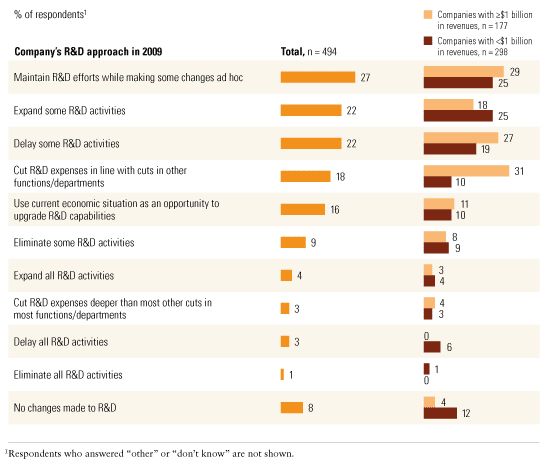
Holding employment steady
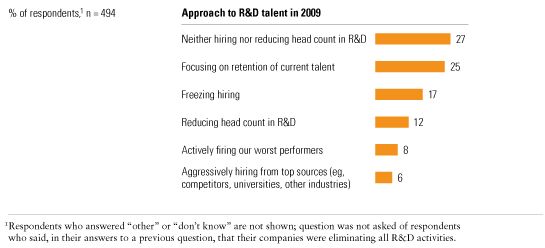
R&D and the bottom line
Two recent McKinsey surveys find that nearly three-quarters of all companies are cutting operating costs in response to global economic conditions, while only 45 percent plan to cut marketing expenditures.2 The present survey shows that R&D is even less affected: only one-third of the respondents say their companies have cut R&D budgets in 2009 (Exhibit 3), and fully 55 percent say their companies aren’t actively trying to reduce R&D costs.
At the 40 percent of companies that are trying to do so, the most common cost-cutting moves the executives report are delaying spending on projects (42 percent), optimizing R&D processes (37 percent), and instituting hiring freezes (31 percent).
Companies recognize that these reductions may be limiting their competitiveness. Executives at the minority of companies that are cutting R&D budgets in 2009 say their top worries are product delays that depress prices or margins, put off product launches, and make companies fall behind their competitors in technology (Exhibit 4).
Little growth in budgets
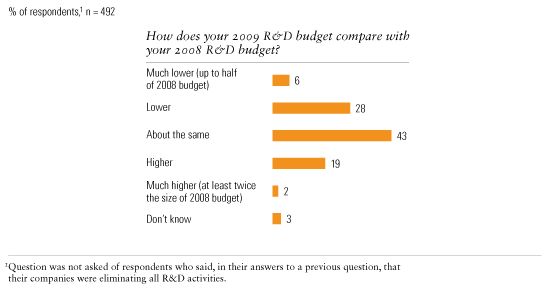
Adverse effects
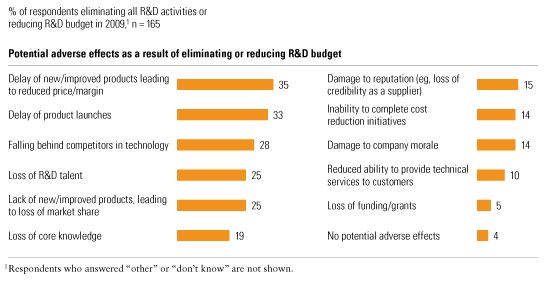
At the project level
A portfolio of R&D projects is the heart of any organization’s innovation efforts. It is therefore noteworthy that nearly four in ten respondents say their companies will have fewer R&D projects this year than last—an unusually high level of reductions, in our experience. Still, about the same proportion of respondents (35 percent) say the number of projects will remain roughly the same. Among companies with at least $1 billion in annual revenues, 52 percent of all executives expect fewer R&D projects, versus 35 percent of the respondents at smaller companies. The difference may reflect the higher degree of entrepreneurialism associated with smaller organizations, which also tend to have more limited project portfolios than large companies do.
What criteria do companies use to evaluate projects for the chopping block? Executives at organizations that are reducing the number of R&D projects in 2009 cite financial metrics (53 percent), project costs (31 percent), and the overall attractiveness of a given market (30 percent) as the top factors influencing the decision. Only 14 percent of the respondents say their companies consider whether projects have successfully reached milestones.
We are reprioritizing to get products to market that will produce sales in the next 180 to 360 days
The mix of projects in R&D portfolios is changing. Many organizations appear to be narrowing their innovation horizons in response to the economic downturn—for example, by shifting projects toward existing product lines, short-term efforts, and minor changes to existing products (Exhibit 5). Contrarians could of course use these findings to leapfrog the competition by seeking higher-risk, higher-return innovations over the longer term.
More product line extensions
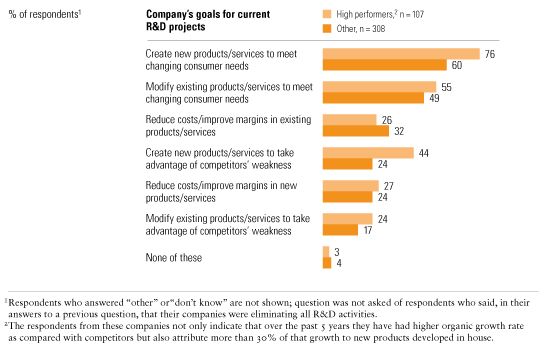
Sustaining advantage in R&D
We identified a group of companies that get the greatest benefit from R&D. The respondents from them not only indicate that, during the past five years, they have had high rates of organic growth as compared with competitors but also attribute more than 30 percent of that growth to new products developed in house. In the areas just described, these high performers are taking a very different approach—one that seems intended to fortify their existing competitive advantages.
Respondents at high-performing innovators are nearly twice as likely as the others to regard the current economic situation as an opportunity to upgrade R&D (24 percent, compared to 14 percent) and are more likely to say their companies are expanding some R&D activities (30 percent versus 21 percent). Indeed, they are more than twice as likely as other respondents to report that their companies’ R&D budgets are either “higher” or “much higher” this year than last (35 percent versus 17 percent). As for setting R&D goals, executives at these companies are more likely than others to say they are focused on creating new products to meet changing consumer needs and new products or services to take advantage of competitors’ weaknesses (Exhibit 6). Most notably, these companies are more than twice as likely as the others to seek projects that combine higher risks with higher returns.
Targeting changes in consumer needs
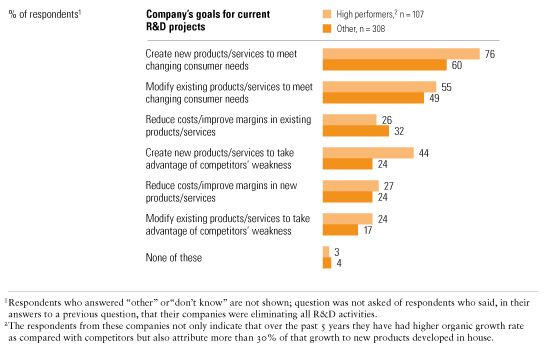
High performers are less likely than other companies to be actively cutting R&D costs (31 percent, compared to 44 percent, respectively). Yet those high performers that are making cuts take a noteworthy approach: their executives are far more likely than other respondents to cite process optimization as the method (52 percent versus 32 percent). This response suggests that high performers focus on longer-term opportunities that not only aid the bottom line but also improve R&D’s overall efficiency.
Executives of companies that get more benefit from their R&D are nearly three times likelier to say that when they take stock of R&D portfolios, they consider whether projects have met milestones. Many companies overlook this point. Respondents at high-performing companies also indicate that the number of projects their companies will undertake in 2009 seems about right. Executives at other companies tend to say their companies are probably cutting back too much.
Looking ahead
-
Although the urge to reduce R&D costs is understandable, not all cuts are created equal. Top companies save money by optimizing and upgrading R&D processes and making them leaner—a path that improves the bottom line while raising productivity and speed to market.
-
A rigorous portfolio approach to managing R&D projects helps senior executives focus on strategically promising efforts while uncovering moribund “zombie” projects that may otherwise go undermanaged—or even unnoticed.
-
Widespread layoffs and industry restructuring, though painful, offer opportunities too. An unprecedented pool of specialist engineering talent—for example, in the automotive industry—is available for companies looking to steal a march on competitors.

